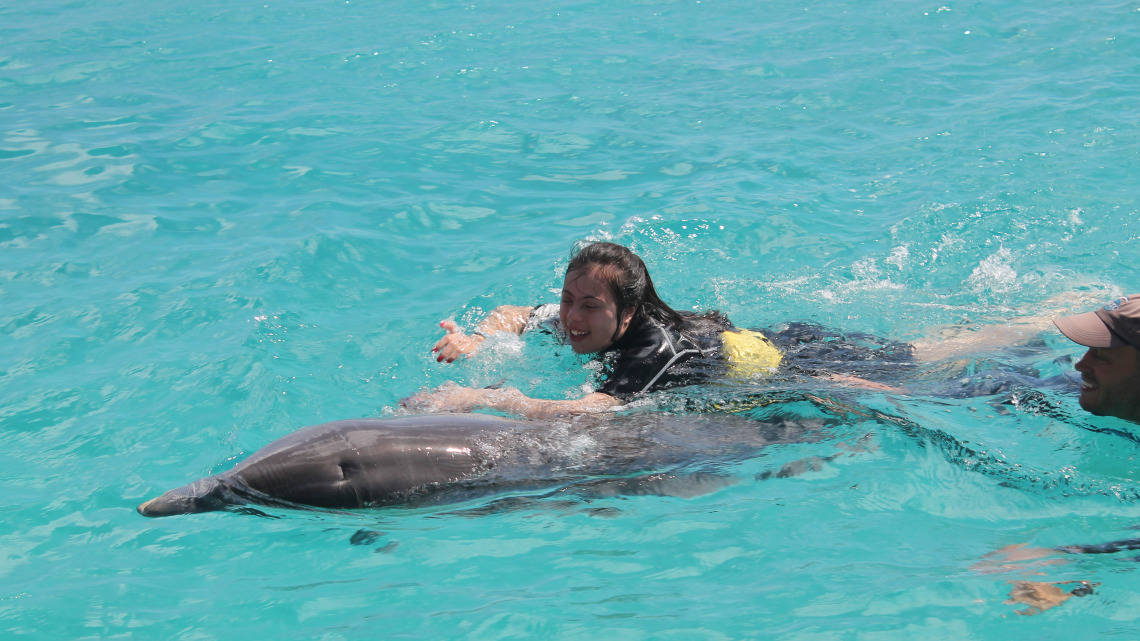In less than two weeks, my husband, daughters and I will travel to Curaçao. Our daughter Atara is enrolled in a very unique therapy program at the Curaçao Dolphin Therapy Centre. I tend to forget to mention that Atara has Down syndrome when telling people what she’ll experience. Stating that allows me to feel like I can go on.
Dolphin Assisted Therapy is a therapy program for children and adults with special needs and dolphins are involved in the treatment. Children actually work with the dolphins in the water and from a platform. The program complements and reinforces the traditional therapy that patients are receiving at home.
Special needs affect the lives of both parents and siblings, therefore their involvement in the therapy is an integral part of its success. Experiencing the Curacao Dolphin Therapy Center (CDTC) program as a family makes it easier to put the positive results into practice after you have returned home. It leads to greater understanding, strengthens the bond and often provides a lot of shared enjoyment. This re-energizing is essential for families and rarely, if ever, do they get the chance to truly get a break. A trip to the CDTC in Curaçao offers that opportunity as well.
This engaging therapy program will surely give Atara a sense of responsibility and it is an undeniably rewarding experience. The synergy between the therapist, the child and the dolphin creates a positive reaction helping to build their self esteem, enhance their motor skills, communication, speech and bring laughter.
Atlantic Bottlenose Dolphins at CDTC are gentle, curious, eager to learn and willing to socialize with humans, characteristics that make them perfect partners in therapy. They interact with the children out of their own free will.
They live in a natural lagoon with fresh, flowing ocean water. They are well-fed, loved and respected in every way.
Sheila Botton, who is the publisher of Events Curaçao and the Canadian ambassador of dolphin aid Canada, walks the families through the process of ensuring that the goal is reached through countless ways.
In April 2012, dolphin aid Canada hosted a kickoff event to which I attended. I made my presence known so my desire to have my daughter connect with a dolphin couldn’t be forgotten. When Atara was very young, I had fleetingly heard about the incredible connection people with Down syndrome generally have with dolphins.
I suppose that’s what set my passion off.
Soon after this event, the Garish family from Montreal departed for Curaçao with Alex, their six-year-old daughter with autism, for a two-week specialized therapy program. Canadian Television CTV W5 supported dolphin aid Canada’s mission with a documentary about the unique work and great success at CTDC. With the assistance of the qualified therapists and the assigned dolphin, Alex was in her element and made remarkable progress.
Dolphin aid Canada also assisted the Larouche family who worked so hard together to raise the funds making the dream of dolphin aid Canada a reality for their son Jonathan who has cerebral palsy. Jonathan and his family departed for Curaçao in July 2012 and it was a real eye-opener. The benefits & breakthroughs of the therapy program at CDTC have gone beyond their expectations and they are dreaming of going back soon.
When dolphin aid Canada hosted another event, I attended and remained in touch. Thanks to fundraisers, donations and earth angels, we were blessed and reached our goal. Living our dolphin-assisted journey so far has been so exciting.
Only a few more days until we leave…
November 11th 2013
“Atara started her therapy today. She swims with Bonnie her dolphin and works with a psychologist, Paul. Atara didn’t hesitate to climb into the water as long as Paul was holding on tight to her. By the end of their session, she was swimming on her own (she wore a buoyancy belt). Atara demanded kisses from Bonnie, she really loved being around her. Initially, Jon and I sat with Paul for a while to give him a good idea of who Atara is.”
Paul and Neelchie work on Atara’s speech during every visit. They’ve settled on one method to encourage her words. Never using signs, they use their fists to distinguish syllables. So far it has worked.
Intervention asks three things of us: 1. Be verbal with a request, 2. Remind with a gesture and 3. Physically show the request. Say the request once, it becomes less important by the 2nd time and in Atara’s case give timeouts immediately when her action is premeditated.
November 24th 2013
“We just arrived home from the amazing dolphin- assisted therapy that Atara received in Curaçao. The experience of it all was definitely life-changing. Dolphin assisted therapy consists of more than just swimming with dolphins. There was the consistency of being with one dolphin for the 2 weeks; Atara swam and worked with a psychologist and a speech therapist. The therapy and process learned are repeated at home. What she took from her time with Bonnie (‘her dolphin’), I cannot put into words. People with special needs are known to have special relationships with dolphins. Basically Atara’s connection with Bonnie was something to see. Her therapist could only explain that he was at her side as a facilitator.”
“To date, Jon and I have been working with the tools that Paul and Neeltje taught us and Atara. Now it’s up to us to create consistency and continuity in our child’s life.”














No Comment